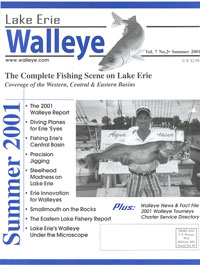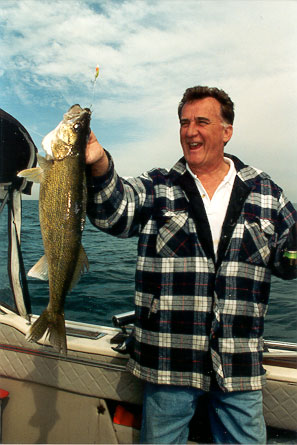Fishing Erie's
Central Basin
by Bud Riser

Order Lake Erie Walleye Magazine
Three Information-Packed Issues for only $10.00
Delivered to your doorstep every March, June and September
|
Fishing Erie's
Central Basin |
|
I
f your nose is buried in this article, you’re probably thinking in the back of your mind, "How much is gas going to cost me to find fish"? Can I catch ‘em close in? Sure you can...it just depends on how many jet skiers you want to get buzzed off by. My fishing day usually starts off like this. That chirping robin goes off at 4:15 AM next to the window. 45 minutes later, I’m creeping along the Lake Erie shoreline dropoffs in 17 to 27 foot depths anywhere from Huron to Conneaut.I’m a die-hard lead chucker so I begin my morning a little shallower than
I probably should...usually in 9 to 12 feet.. .just because I can. Bouncing
bottom with jigs and minnows or crawling a weight forward spinner generally
produces a couple early AM fish in skinny water.
.just because I can. Bouncing
bottom with jigs and minnows or crawling a weight forward spinner generally
produces a couple early AM fish in skinny water.
If that doesn’t do it, I set up my next drift from 10 to 14 feet and maybe switch to a slip sinker and worm harness combo. Bango!—one or two more fish, including the world’s largest sheephead.
This time of year, I still like silver, gold or chartreuse color combinations. No matter what your lure choice is, concentrate on using the lightest possible baits but still maintain contact with the bottom.
By this time, it’s 9:00 and a boat or two has showed up. I usually slide into 17 to 27foot depths and try blade bait jigging or casting a worm harness in a sweeping arc pattern (casting the swing as charter captains call it).
One or two more fish, a couple of smallmouth bass and a perch or two...not bad for 3 or 4 drifts. 9:45 to 10:00AM and more boats show up along with the first jet skier, churning up the shallows. Now it’s time to make the offshore run.
Many mornings may find that you’ve already limited out on walleyes and you may want to play around with smallmouth bass in 18 to 30 foot depths or fish for perch in 45 to 55 feet instead.
I prefer to get out the heavy artillary and troll offshore for steelhead trout and walleyes. They are often found in the same area of the water column as June/July temps warm up and the summer thermocline sets up.
I generally turn the gain way up or to full on my fishfinder to show the thermocline. It usually looks like a fuzzy, wavy band on your depthfinder and is about 5 or 6 feet thick, with 67-68 degree water on top. That’s where the walleye are, above the thermocline.
I target my trolling baits for walleye to run from 32 to 42 feet deep while my steelhead baits are set to run the deeper part of the thermocline. Colder temperatures hold more steelies as it cools from about 65 to 58 degrees. It’s easy to find with a temperature probe.
Right now, I’ll bet you're still thinking, "20 miles out??" There’s that gasoline question again.
In June and early July, walleye and steelhead action takes place within a reasonable distance from shore. 3 to 6 miles out can be a good early summer starting point and you can work your way out from there.
Last year anglers found schools of walleye and steelies off Huron, Lorain, Bay Village, Cleveland and points east early last year. Walleyes were spread more widely but those darn trout were everywhere! It was a steelhead bonanza!
My best day produced 30 steelies on line by 12:30 in the afternoon. Captain Bob MacFarland on the "Naughty Buoys" had about 45 on and one chinook as well.
My trip was with two pals who had never been trolling before. Here’s how we chase open water walleyes and troutskiis. First, set up a communications hotline. I never hit the water without calling at least five friends to check action as well as internet fishing websites.
Charter Captain, Andy Emrisko, of "Wavewalker" charters uses his own unique formula. "If the TV weather says the lake temperature is 48 degrees, I start out in 48 feet of water. 55 degrees finds me looking
around 55 feet", explains Emrisko. "I don’t know if it works everywhere, but off Cleveland, it’s been fairly reliable.Captain John Solecki starts hitting walleyes off Rocky River and Bay Village, Ohio in mid-June when lake temps approach the mid 60’s. "I like to start shallow (45 feet) and work my way north from there", says the skipper of the "Solucky" charter boat.
John is known for trolling worm harness rigs off Dipsy Divers and from his planer boards. "We’ll often run 12 and even 14 lines until we find what color and action they prefer. Then, we switch a couple more lines to that type of lure or color".
A number of guys in our information network actually create a grid chart of the areas we fish. It’s unbelievably helpful at a quick glance. There’s a lot of water to cover and if you have 3 to 5 boats covering it, a lot of guesswork is removed.
The last 2 years found walleye in depths of 32 to 70 feet of water, both suspended and occasionally hugging bottom. From early to mid-June, don’t overlook those shoreline breaks for bottom-hugging walleyes.
Anglers have been extremely successful both day and night trolling. "eyes will suspend higher toward the surface as the sun goes down. It doesn’t take them long to become active feeders at dusk.
I’ve actually witnessed a gang of steelhead slashing the surface like white bass as they chowed down on emerald shiner minnows. We could easily cast to them that evening with spoons or spinners.
Trolling baits for walleye vary greatly from small-bladed Northland Tackle worm rigs to #6 or #7 double willow leaf worm harnesses that "Solucky" charters likes to run. Many captains like crankbaits like Reef Runners, Bombers and Storm Thundersticks off side planers. Recently walleye have shown a preference for smaller stick baits over the larger 25A Bomber sizes.
Spoon sizes dropped into the mini and micro mini sizes for both walleye and trout but last year’s results showed NK-28’s, Wolverine Silver Streaks and Pro Kings in standard sizes working well again.
One thing we learned over the past three years was that if fish show a preference for smaller cranks and spoons, you better use them and not try to force feed ‘em. Sure, we all probably own a couple hundred dollars worth of lures, but if they’re too big or the wrong color or action, it doesn’t mean a thing.
I’m thrifty. It took me nearly half a fishing season to buy smaller spoons but once I did, my central basin success improved considerably. Apparently those walleyes were simply feeding on smaller fish.
Even the worm harness rigs went with small-bladed gold or silver spinners producing best. Try gold when the mayfly hatch is in full swing. Northland Tackle’s Rattling Rainbow Spinner rigs have been a top favorite of mine for years. Their Rock Runner bottom bouncer and spinner combo has been especially deadly along Lake Erie shoreline breaks and dropoffs.
Buy bottom bouncers heavy enough to run you line as straight up-and-down as possible for maximum sensitivity and hookset. 2 to 3 ouncers are usually good to 30 feet, depending on water conditions. Slow trolling with a lift-and-bounce has worked best for me. Did I also mention that I prefer using Berkley Fireline or Spiderwire?? It really helps a lot with this technique.
Steelhead showed a consistent preference for smaller spoons but the occasional fish would still hit full-sized ones like Pro-Kings or NK-28’s. Any spoon with a copper back has been consistent for both ‘eyes and trout in Cleveland’s offshore waters. Rainbow trout, watermelon, clown, black and purple and green or blue with silver combos were still good colors.
The astounding new kids on the block were Northland Tackle’s Fire Eye spoons and the Michigan Stinger Scorpions along with my favorite Wolverine Silver Streak and micro streak patterns. Colors like "monkey puke, confusion, shrimp and boy/girl" became common to hear on the radio last season.
Trolling speeds are generally about 2-2 1/2 mph for walleye while steelies like baits running a little "hotter" up to about 2 3/4 mph consistently. I travel everywhere with a GPS and a compass. They’re invaluable when searching for open water hotspots. In June, patterns have found fish offshore in 35 to 45 foot depths. They may be suspended up high so look for ‘em.
In July, walleye and steelhead are chased in 45 to 65 feet of water and both species can be located high as well as down into the thermocline. Last year, many anglers trolled Dipsy Divers 50 to 80 feet out on 1, 2 and 3 settings respectively for trout. Walleye hit deeper with setting farther back at 145, 165 and 185 feet of line out on 1,2 and 3 Dipsys. Fluorescent colors like Chartreuse and Fire Tiger took most of the ‘eyes while copper and rainbow trout patterns caught most of my steelies.
By mid-July, lake temps are usually at 70-72 degrees down deep. Going into late July and August, water temps peak and motoring out 25 miles or more is not unusual to locate good action. By mid-August, many anglers shift over to yellow perch or smallies instead of spending all the time and gas money chasing distant fish.
Nearshore (4 to 7 miles out) walleye activity usually picks up off Lorain, Vermilion and Huron but that’s another article for the fall issue. See you on the water!